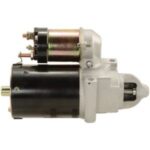The brake pedal in your car is ingeniously designed to amplify the force from your foot many times over before it even engages the brake fluid. This mechanical advantage is crucial for effectively stopping a vehicle, which can weigh thousands of pounds.
Consider a simple lever system as illustrated. When you apply force (F) to one end of a lever, the force is magnified at the other end depending on the lever arm lengths. If one end of the lever is twice as long as the other, the force at the shorter end is doubled. However, this increased force comes at the cost of distance; the shorter end moves only half the distance of the longer end. By altering the ratio of lever arm lengths, engineers can precisely tune the force multiplication.
Alt text: Diagram illustrating a lever system with force multiplication, showing input force F and output force 2F with corresponding distances.
The core principle behind a car’s braking system is hydraulics. Hydraulic systems utilize an incompressible fluid, typically a specialized oil, to transmit force from one point to another. This method is not only efficient but also allows for force multiplication within the system.
Basic Hydraulic Brake System Explained
Imagine two pistons nestled within glass cylinders, both filled with oil and connected by an oil-filled pipe. When you exert downward pressure on one piston, this force is transferred through the oil to the second piston. Due to oil’s incompressibility, the force transmission is highly efficient, ensuring that nearly all the applied force reaches the second piston. A significant advantage of hydraulic systems is the flexibility in routing the connecting pipe; it can be of any length and shape, navigating around various components between the pistons. Furthermore, a single master cylinder can branch out to control multiple slave cylinders, if needed.
Alt text: Illustration of a simple hydraulic system with two pistons and cylinders connected by a pipe, demonstrating force transmission through fluid.
Force Multiplication in Hydraulic Brakes
Hydraulic systems are excellent for easily multiplying or dividing force. This concept is similar to how block and tackle systems or gear ratios work, where force is traded for distance. In a hydraulic brake system, force multiplication is achieved by varying the size of the pistons and cylinders.
Alt text: Diagram of a master cylinder connected to two slave cylinders in a hydraulic system, showing distribution of force.
Consider a scenario where the master cylinder piston is smaller than the slave cylinder piston. For example, if the master cylinder piston has a diameter of 2 inches (radius of 1 inch), and the slave cylinder piston has a diameter of 6 inches (radius of 3 inches). The area of a piston is calculated using the formula Pi * r². Therefore, the master cylinder piston area is approximately 3.14 square inches, while the slave cylinder piston area is approximately 28.26 square inches.
Alt text: Schematic showing hydraulic multiplication with different sized pistons, illustrating force increase from smaller to larger piston.
The slave cylinder piston is nine times larger in area than the master cylinder piston. This area difference results in force multiplication. If you apply a 100-pound force to the master cylinder piston, the force exerted on the slave cylinder piston will be nine times greater, or 900 pounds. However, to move the slave cylinder piston a distance of 1 inch, you would need to depress the master cylinder piston 9 inches. This trade-off between force and distance is fundamental to how hydraulic brakes provide the necessary stopping power for a vehicle.
In summary, car brakes utilize a combination of mechanical leverage and hydraulic principles to effectively and efficiently bring a moving vehicle to a halt. The brake pedal initiates force multiplication through levers, which is then further amplified by the hydraulic system, ensuring sufficient force is applied to the brake pads to create friction and slow down the wheels.

